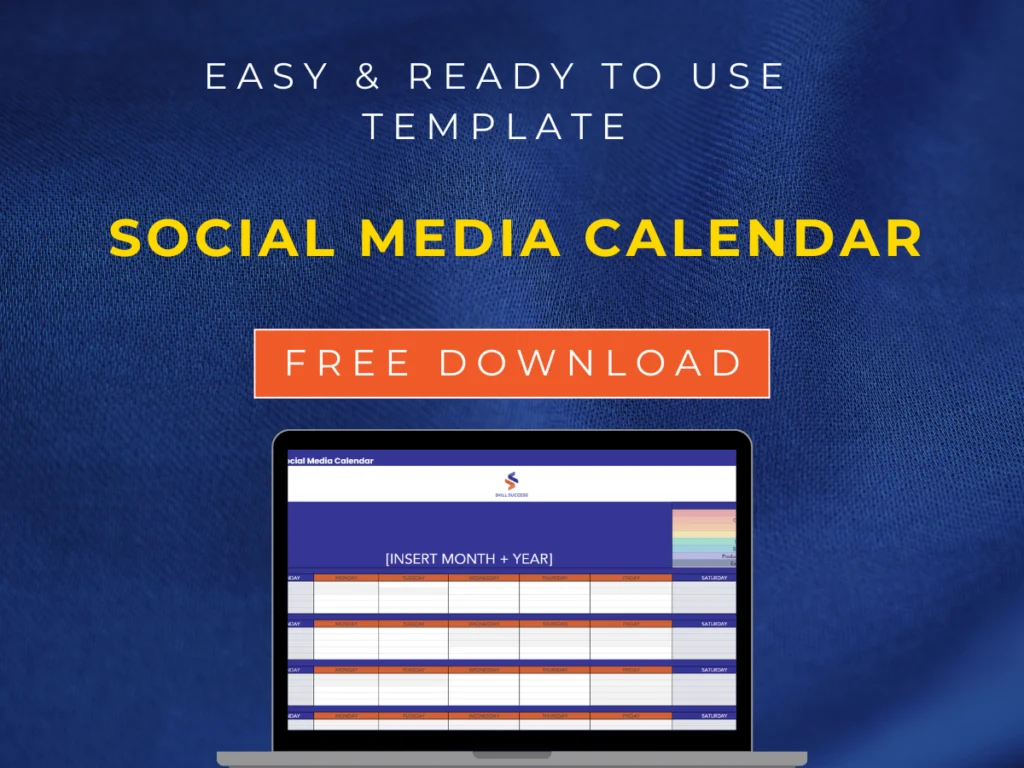Managing a social media calendar can feel overwhelming, especially when juggling multiple platforms, campaigns, and post types. At Skill Success, we rely on a structured content calendar to keep our social media strategy organized and effective. With multiple team members working on blog promotions, course launches, and community engagement, having a clear and actionable plan is essential.
Our Social Media Calendar Template helps us stay on track, align our content with marketing goals, and ensure every post goes live at the optimal time. Now, we are sharing this resource with you to make your content planning just as seamless!
Why Use a Social Media Calendar?
Social media offers an immense opportunity for businesses to connect with their audience. As of early 2025, there are 5.24 billion social media users worldwide, accounting for 63.9% of the global population. This vast reach underscores the importance of having a structured approach to content planning and engagement.
A well-structured social media calendar helps you:
- Plan content in advance to avoid last-minute scrambles
- Maintain consistency across platforms
- Track campaigns, blog promotions, product launches, and more
- Ensure team alignment with an approval process
- Measure the effectiveness of different content types
Key Elements of Our Social Media Calendar Template
Monthly calendar tab
This specific tab helps plan and organize content efficiently across platforms. Follow these steps to maximize its impact:
1. Make a copy
Click File → Make a Copy to save and edit your own version.
2. Understand content categories
Each entry is categorized for clarity:
- Holiday – Seasonal posts
- Campaign – Marketing initiatives
- Ebook – Downloadable resources
- Webinar – Event promotions
- Blog Post – Content sharing
- SlideShare – LinkedIn presentations
- Product Launch – New releases
- Experiment – Strategy testing
- Other – Miscellaneous content
3. Schedule your content
Mix promotional, educational, and engagement-driven content to keep your audience interested, while also leaving room for real-time interactions, trending topics, and last-minute updates to maintain relevance.
4. Stay flexible & optimize
- Adjust posts based on engagement data.
- Test different formats to improve reach.
- Keep reviewing and refining your strategy
Schedule tab
Our template includes columns to simplify scheduling and tracking, ensuring each post aligns with your marketing goals. Here’s what you’ll find:
1. Publish date
The scheduled posting date for each piece of content. Having this set in advance keeps your content flow organized.
2. Campaign type
Classifies posts into different categories such as Marketing Campaigns, Evergreen Content, Right-Time Posts, and Course Promotions. This helps structure your content strategy.
3. Topic/Title
Each post’s main focus, whether it’s promoting a new blog post, webinar reminder, product launch, or industry trend.
4. Content/Details
A brief description of what the post will cover. This ensures clarity for your team when reviewing content before publishing.
5. Social network & post type
Identifies where the content will be posted (Instagram, Facebook, Twitter, LinkedIn, YouTube) and whether it’s a Link Post, Regular Post, Chained Post, or UGC (User-Generated Content).
6. Content type
Specifies whether the post includes a photo, video, slide deck, blog link, or other assets.
7. Copy & asset
Includes the post’s written copy and the image or video file name for easy reference.
8. Link & shortened tracked link
Each post contains a direct link (to a blog, product page, or external source) and a bit.ly-style shortened link to track engagement.
9. Publishing time
The exact time the post is scheduled to go live, ensuring strategic timing for maximum engagement.
10. Approval & live link
Posts must pass through approval stages before going live. Once published, the live link is added for reference.

How to Use This Template
- Plan ahead: Fill in the calendar with posts at least two weeks in advance to maintain consistency.
- Categorize your content: Label each post by campaign type to balance promotional, educational, and engagement content.
- Use shortened links: Track performance using bit.ly-style links to monitor click-through rates.
- Follow the approval process: Ensure all posts are reviewed before publishing.
- Optimize posting times: Schedule posts based on audience activity insights for each platform.
Take These Course for Social Media Management
A Complete Guide To Instagram Marketing 2021 And Beyond
Ready to grow your Instagram and turn followers into real customers? This beginner-friendly course is perfect for anyone with under 10,000 followers who wants to build a strong, trustworthy brand on Instagram. Learn how to attract targeted followers, master Instagram’s latest features, and convert your audience into loyal buyers
The Easiest Ways To Drive Highly Targeted Traffic From Facebook To Your Business
Want to bring more of the right people to your business? This quick, beginner-friendly course shows you how to drive highly targeted traffic from Facebook using proven advertising strategies. In just 27 minutes, you will learn exactly how to set goals, build ads, and get results—fast.
Ways To Make Money Online: Using The Power Of Social Media!
Discover the easiest ways to make money online using the power of social media. This beginner-friendly course breaks down proven strategies across Facebook, YouTube, LinkedIn, Instagram, and Pinterest—helping you turn likes, views, and follows into real income. Learn at your own pace and start building your online business today!
Key Takeaways
A social media calendar is essential for maintaining consistency, streamlining content planning, and ensuring posts align with marketing goals. It helps teams plan ahead, categorize content, track engagement, and optimize posting times for maximum impact. Incorporating approval workflows, structured scheduling, and shortened links for tracking allows brands to efficiently manage multiple platforms and content types.
To simplify your content strategy, download our ready-to-use Social Media Calendar Template and start planning today!
DOWNLOAD NOW
